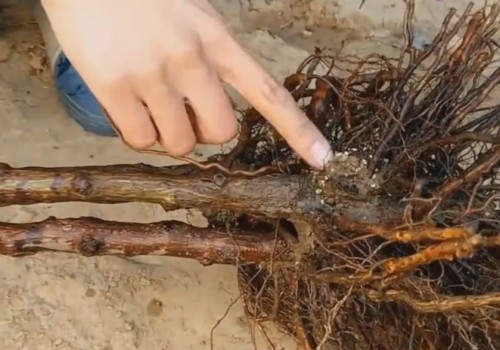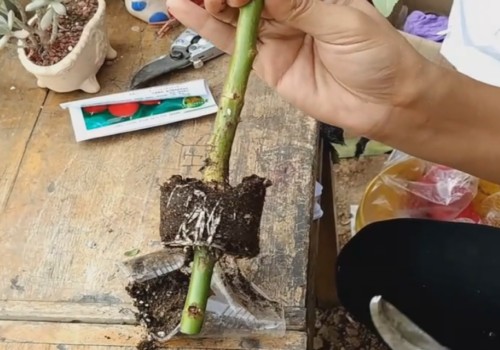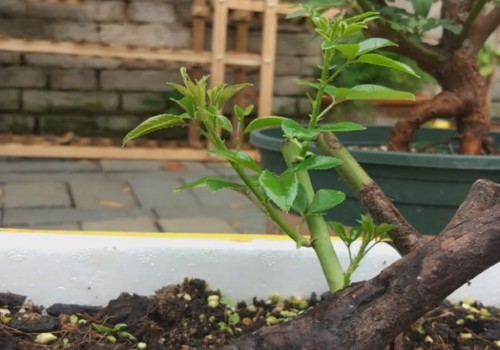Rose cultivated in autumn and grafted rose in spring
Rose stakes are most suitable for planting in autumn, so we can buy them back and grow them later this season. If the rose stump survives smoothly, we can use it as a rootstock to graft tree-shaped rose next spring.

However, when it comes to autumn, it is usually not easy to buy rose stakes. And the rose pile is generally cultivated by hardwood cuttings, after all, the cutting survival rate is high, the root system grows rapidly, and it is easy to grow seedlings.
By observing the root of the rose cuttage pile purchased, we can generally judge that the cutting substrate is a mixture of perlite and garden soil. If the rose stakes we buy are tall, they can usually be used for grafting to cultivate tree-like roses, or even shrub roses or rattan roses.
In fact, we generally only need to buy stakes with a diameter of 2 cm and a height of 50-60 cm, which can be used for grafting tree stumps. Moreover, the price of rootstocks of this size is not high, which is relatively affordable. Let's take a look at how to plant it.
First of all, we still need to use some rooting agents and carbendazim fungicides on the root of the pile, which can be soaked in the solution for 20 minutes. This can not only prevent root nodule disease, but also promote the rapid germination and growth of root system of rose pile, and it is easier to survive after transplanting.
If we want to plant the rose pile on the ground, the original only needs to dig a hole in the right place and bury some rotten organic fertilizer in the pit, if any, it would be better to bury some beneficial bacteria. Then the rose pile is implanted directly into it. But if we are potted, the substrate must be prepared. It is recommended to use coarse coconut bran and fine coconut bran, then mix well according to the proportion, and then mix in some garden soil, perlite and so on.
After matching the substrate, we can directly put the rose stake on the pot. But on the basin can not add any form of base fertilizer, generally after planting, we in the basin is evenly sprinkled with some fermented and rotten organic fertilizer. Then mix it with the topsoil, so that the effect is better, and it is not easy to produce fertilizer damage, but also can get nutrients.
If we use fertilizer as base fertilizer, it is often easier to burn roots. After all, the space in the basin is limited, so it is reasonable to spread rotten organic fertilizer on the basin surface. It can be maintained for a year, and when the plant grows a lot of branches in May-June of the next year, we will use it as a rootstock for grafting tree-like rose, the effect is very good.
Time: 2019-05-23 Click:
- Prev

How to transplant rose propagated under high pressure into pot
Many flowers and plants can cultivate potted seedlings by means of high-pressure propagation, and this method can also be used for rose. When the base of the rose rod propagated under high pressure takes root, then we can cut it from the mother plant and transplant it into a pot. that
- Next

How to plant rose grafted rootstock
Generally speaking, the rose stakes we dig from the wild are strangely shaped, and when we cultivate them into flowerpots, many roots are usually exposed on the basin surface, because the root system is too long and too developed. Even if we use a deeper gallon basin, the root system can still reach the bottom of the basin.
Related
- Fuxing push coffee new agricultural production and marketing class: lack of small-scale processing plants
- Jujube rice field leisure farm deep ploughing Yilan for five years to create a space for organic food and play
- Nongyu Farm-A trial of organic papaya for brave women with advanced technology
- Four points for attention in the prevention and control of diseases and insect pests of edible fungi
- How to add nutrient solution to Edible Fungi
- Is there any good way to control edible fungus mites?
- Open Inoculation Technology of Edible Fungi
- Is there any clever way to use fertilizer for edible fungus in winter?
- What agents are used to kill the pathogens of edible fungi in the mushroom shed?
- Rapid drying of Edible Fungi

